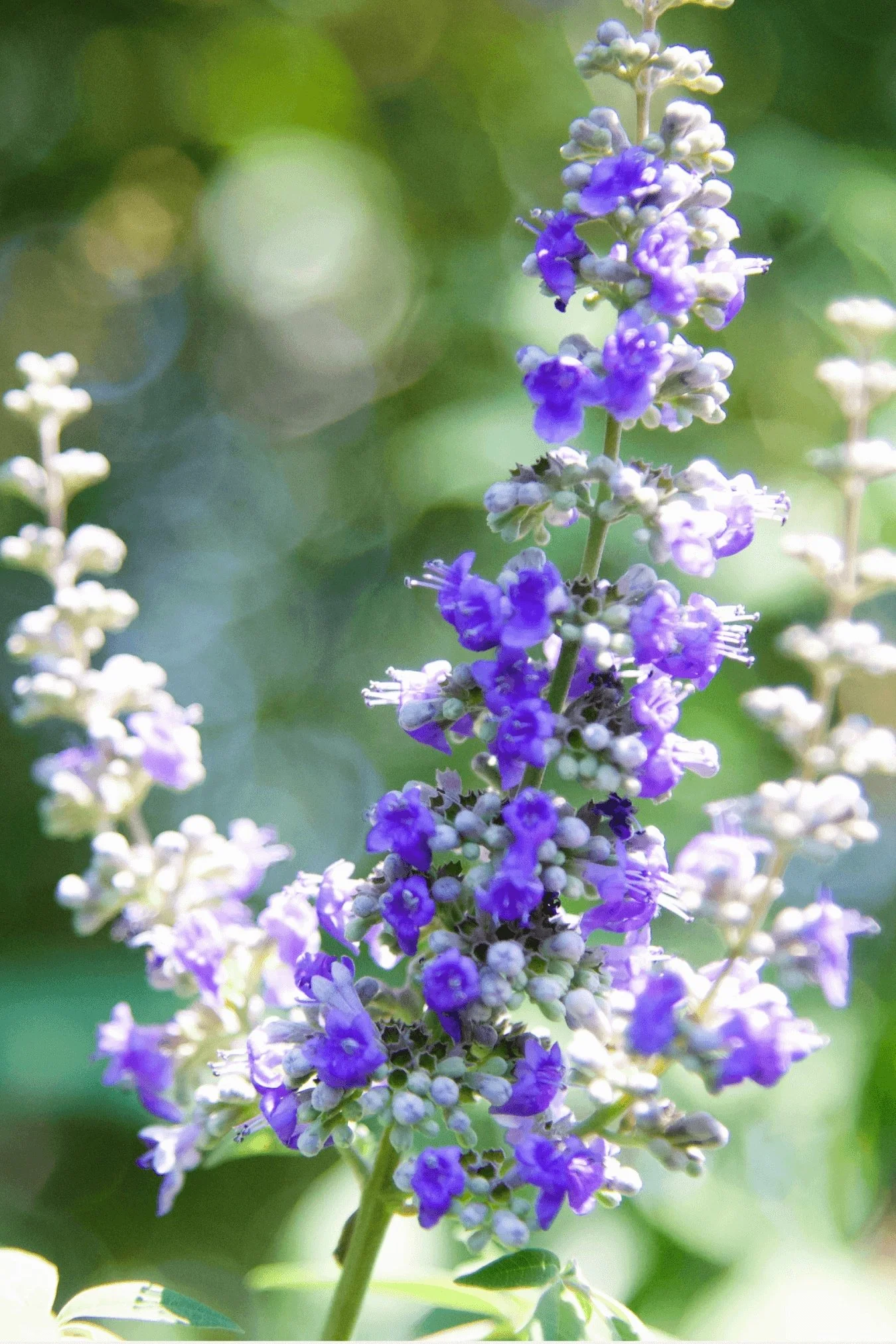Vitex (Chasteberry): the Perimenopausal Hormone Whisperer
Vitex (Chasteberry) can be an herbal ally for the perimenopausal transition
Vitex agnus-castus is a flowering shrub found in the Mediterranean, parts of Asia, and the US. The berries, resembling small peppercorns, have been used traditionally for centuries for various female reproductive conditions including hormonal fluctuations during the perimenopausal transition. Vitex has a good safety profile and has been widely used, especially for low progesterone, infertility, PMS, cyclic breast tenderness, menstrual migraines, PCOS, missed, irregular, or heavy periods. It is thought to work by modulating the activity of the pituitary, affecting LH and FSH (which signal progesterone and estrogen release), suppressing prolactin release, and stabilizing hypothalamic-pituitary-ovarian (HPO) axis signaling during hormonal fluctuations.
Vitex may be helpful in each stage of the perimenopausal transition
The Whispering Winds: Very Early Perimenopause
Vitex begins its magic here, gently nudging the pituitary gland to modulate hormones (boosting progesterone, calming estrogen), smoothing out those early mood swings and sleep disruptions (due to hot flashes or night waking, sometimes associated with anxiety).
The Hormonal Roller-Coaster: Early Menopause Transition
As time goes on, cycles get creative, often shorter, sometimes longer. Estrogen may spike high, then tumble, while progesterone can’t keep up. Symptoms like breast pain, migraines, and heavier periods may appear. Mood swings and irritability may be overwhelming. Vitex shines as a hormone whisperer, helping to steady the see-saw of excess estrogen and low progesterone, and for many women, is effective in reducing headaches, breast tenderness, and mood swings.
The Final Countdown
Periods in this stage become rare, estrogen drops, and the classic symptoms including hot flashes, night sweats, brain fog, and fatigue take center stage. Sleep might become even more challenging. Vitex’s adaptogenic powers help the pituitary stabilize waning hormones, reducing the frequency and intensity of hot flashes and night sweats. Even in this final stretch, Vitex can offer support. While not a cure-all, many women report better sleep, steadier moods, and fewer night sweats with continued use.
Usual Dose
Capsules: 20-40 mg per day (up to 240 has been shown to be safe). Usually taken in the morning.
Extract or tincture: 40-80 drops (2-4 mL) per day, which can be taken in a single dose or divided into two doses, dissolved in water.
Note: it can take up to 3 months to notice the full benefit, so patience may be needed.
Safety
Depression: though Vitex is well tolerated by most women, there have been a few reports of worsening depression, so women should monitor for this; if symptoms are severe or persistent, discontinue use and consult a healthcare practitioner.
Hormone-sensitive cancer: because Vitex may modulate both estrogen and progesterone, women with a history of a hormone-sensitive cancer should discuss with a medical provider before beginning to take Vitex (or any medication, herb, or supplement).
Pregnancy & Breastfeeding: pregnant women should avoid all herbs and supplements without safety data specifically in pregnancy (like Vitex). Vitex is used in breastfeeding at low doses to increase milk supply.
Contraception: because increased fertility may occur, women who do not wish to conceive should be sure to use a contraceptive method. AND because Vitex may affect hormone levels, it is wise to use a barrier method like condoms in case hormonal birth control is less effective at preventing ovulation.
Allergy: severe allergic reaction is rare but should be evaluated immediately by a medical provider.
Most common side effects
Some users have reported mild side effects, mainly when first starting this medicinal plant. These may include nausea, upset stomach, diarrhea, headaches, skin rash or itching. Because Vitex can modulate hormones, some women notice changes in menstrual cycle or breast tenderness.
The Evidence
As is often the case, clinical studies for herbal supplements are rarely funded, and data on Vitex are still emerging. But there are a couple of small randomized controlled trials (RCTs) showing that Vitex can significantly reduce total menopausal symptoms, especially anxiety and hot flashes, compared to placebo. Vitex has been the subject of multiple observational studies showing benefit for mood and sleep for women with PMS (where progesterone is decreasing as it does in perimenopause). Other studies have used a combination of products including Vitex, or results have been mixed. Long term use of Vitex has not been extensively studied.
Abbaspoor, Z., Hajikhani, N. A., & Afshari, P. (2011). Effect of Vitex agnus-castus on menopausal early symptoms in postmenopausal women: A randomized, double blind, placebo–controlled study. British Journal of Medicine and Medical Research, 1(3), 132–140. https://doi.org/10.9734/BJMMR/2011/163
Kenda, M., Kočevar Glavač, N., Nagy, M., & Sollner Dolenc, M. (2021). Herbal products used in menopause and for gynecological disorders. Molecules, 26(24), Article 7421. https://doi.org/10.3390/molecules26247421
Loch, E. G., Selle, H., & Boblitz, N. (2000). Treatment of premenstrual syndrome with a phytopharmaceutical formulation containing Vitex agnus castus. Journal of Women's Health & Gender-Based Medicine, 9(3), 315–320. https://doi.org/10.1089/152460900318515
Naseri, R., Farnia, V., Yazdchi, K., Alikhani, M., Basanj, B., & Salemi, S. (2019). Comparison of Vitex agnus-castus extracts with placebo in reducing menopausal symptoms: A randomized double-blind study. Korean Journal of Family Medicine, 40(6), 362–367. https://doi.org/10.4082/kjfm.18.0067
Ready to explore your options for perimenopausal or menopausal symptoms?
If you feel ready explore all the treatment options available (including hormone therapy, lifestyle changes, and herbs and supplements), for your specific symptoms and your unique situation, schedule a complimentary visit so we can meet briefly and talk about your concerns.
About The Author: Heidi Biegel, CNM, MSCP
I’m a Certified Nurse-Midwife with a passion for supporting women through all of life’s major transitions — with a focus now on midlife, perimenopause & menopause. I blend down-to-earth women’s wisdom with evidence-based solutions to common concerns. I’m certified by the Menopause Society and trained in integrative and functional medicine so that I can offer a wide range of information, support, and guidance to women during this critical time in their lives.
Disclaimer: This blog post is for educational purposes only and is not intended as medical advice. Always seek professional medical care when you have questions relating to your specific health concerns.


